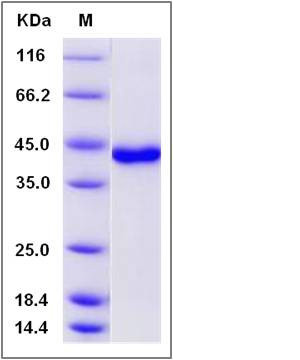Human / Mouse USP46 Protein
USP46
- 100ug (NPP4375) Please inquiry
| Catalog Number | P12976-HNCB |
|---|---|
| Organism Species | Human |
| Host | Baculovirus-Insect Cells |
| Synonyms | USP46 |
| Molecular Weight | The secreted recombinant human USP46 consists of 366 amino acids and predicts a molecular mass of 42.4 KDa. The apparent molecular mass of the protein is approximately 43 Kda in SDS-PAGE under reducing conditions due to glycosylation. |
| predicted N | Met |
| SDS-PAGE |  |
| Purity | > 95 % as determined by SDS-PAGE |
| Protein Construction | A DNA sequence encoding the human USP46 [(Identical to the mouse USP46 (NP_808229.1)] (Met1-Glu366) was fused with the SUMO tag at the N-terminus. |
| Bio-activity | |
| Research Area | Cancer |Cell cycle |Ubiquitin-Proteasome Pathway |Deubiquitinase |
| Formulation | Lyophilized from sterile 20mM Tris, 500mM NaCl, pH 7.4, 10% gly 1. Normally 5 % - 8 % trehalose, mannitol and 0.01% Tween80 are added as protectants before lyophilization. Specific concentrations are included in the hardcopy of COA. |
| Background | USP46 belongs to the peptidase C19 family, USP12/USP46 subfamily. Deubiquitinating enzymes (DUBs) are a large group of proteases which are also commonly referred to as deubiquitinating peptidases, deubiquitinating isopeptidases, deubiquitinases, ubiquitin proteases, ubiquitin hydrolyases, ubiquitin isopeptidases, or Dubs. They regulate ubiquitin-dependent metabolic pathways by cleaving ubiquitin-protein bonds. They also may act as negative and positive regulators of the ubiquitin system. Besides ubiquitin recycling, they are also involved in processing of ubiquitin precursors, in proofreading of protein ubiquitination and in disassembly of inhibitory ubiquitin chains. USP46 is a deubiquitinating enzyme that plays a role in behavior, possibly by regulating GABA action. It may act by mediating the deubiquitination of GAD1/GAD67. USP46 has almost no deubiquitinating activity by itself and requires the interaction with WDR48 to have a high activity and it is not involved in deubiquitination of monoubiquitinated FANCD2. |
| Reference |
